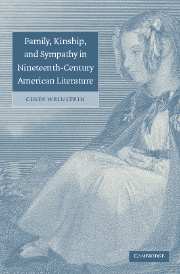Book contents
- Frontmatter
- Contents
- Acknowledgments
- Introduction
- 1 In loco parentis
- 2 “A sort of adopted daughter”: family relations in The Lamplighter
- 3 Thinking through sympathy: Kemble, Hentz, and Stowe
- 4 Behind the scenes of sentimental novels: Ida May and Twelve Years a Slave
- 5 Love American style: The Wide, Wide World
- 6 We are family, or Melville's Pierre
- Afterword
- Notes
- Select bibliography
- Index
- Cambridge Cultural Social Studies
4 - Behind the scenes of sentimental novels: Ida May and Twelve Years a Slave
Published online by Cambridge University Press: 22 September 2009
- Frontmatter
- Contents
- Acknowledgments
- Introduction
- 1 In loco parentis
- 2 “A sort of adopted daughter”: family relations in The Lamplighter
- 3 Thinking through sympathy: Kemble, Hentz, and Stowe
- 4 Behind the scenes of sentimental novels: Ida May and Twelve Years a Slave
- 5 Love American style: The Wide, Wide World
- 6 We are family, or Melville's Pierre
- Afterword
- Notes
- Select bibliography
- Index
- Cambridge Cultural Social Studies
Summary
Behind the scenes of many sentimental texts lie the traces of slave narratives. Such a claim, I realize, requires this immediate counter-statement – that sentimental texts radically differ from slave narratives, even though both genres share a conceptual investment in the matter of eventual self-possession, a structural equivalence in their protagonists' journey from a state of bondage into one of freedom, and an affective contiguity in their concern for the condition of their readers' sympathies. The aim of this chapter is to provide a more nuanced reading than currently available of the uses to which the tropes, rhetoric, and goals of slave narratives are deployed within sentimental texts. I also hope to make the rather simple point that sentimental texts, for all of their intersections with the slave narrative genre, register in a variety of ways the all-encompassing difference between a sentimental narrative and a slave narrative, which is to say that the texts under consideration recognize the difference between someone who is and is not a slave. A pro-slavery text like Hentz's not only does not acknowledge this decisive distinction but works to erode it.
In fact, this chapter continues where my reading of Effie's symbolic function in The Planter's Northern Bride left off. There, let us recall, Moreland's daughter is kidnapped by her biological mother and becomes, analogically speaking, a fugitive slave – advertisements are posted and her return to her father and Eula is eventually secured – whose return to the plantation guarantees her future happiness.
- Type
- Chapter
- Information
- Publisher: Cambridge University PressPrint publication year: 2004



